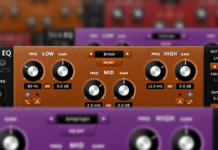While this term may seem alien to most, you would not have escaped VST plugins if you are a part of the ever-increasing group of people who spent time recording and producing music on their computers.
You could be a small, bedroom-sized studio owner who just does this on the side as a hobby, or you could be running a professional studio that produces music for others as well.
There is no way for you to produce real quality content without using the many different VST plugins that are easily available across platforms.
If you are looking for a guide that will help you understand VST plugins, all you need to do is keep reading!
What Is VST?
VST is the short form commonly used for Virtual Studio Technology.
This technology was developed to replace the traditional audio recording hardware with the help of software that could do the job in a much easier manner. This interface standard works to connect synthesizers and effects to editors and recording programs focused on audio.
The main difference in the process — when you compare the traditional methods with VST — is that you don’t have to bother about routing the audio out of the computer to the units made especially for hardware effects and then get it back to the computer. Instead, all of it is done internally.
There are two types of VST plugins that you absolutely need to know about if you are into recording and producing music — VST effects and VST instruments. Within each of these categories, there are tons of different options for you to choose from. All of these may perform similar or vastly different functions.
Let’s delve deeper into both these types of plugins in the next section.
VST Effects and VST Instruments
In this section, we will be looking at the two main types of VST plugins that you can incorporate into your audio recording, editing and producing process.
The first of these is the VST effects, which also include a large number of different sub-categories within the larger category of effects.
Similarly, the second type of plugins are VST instruments, which also cover a wide range of categories, some of which will be discussed in greater detail below.
VST Effects
The first type — VST effects — work like most other types of audio effects and can be used to process audio in a more effective manner, as it gives you the option of using it in real-time. VST effects work best when they are used in combination with the right low-latency soundcard
If there is a particular audio effect found in the form of hardware, there will definitely be a VST option for the same.
The different effects can be split into many different categories, the most popular of which are mentioned below:
- Modulation effects — For example, Chorus, Flanger, and Phaser.
- Time-based effects — For example, Reverb, Delay, and Echo.
- Spectral effects — For example, EQ and Panning
- Dynamic effects — For example, Compression and Distortion
- Filters — For example, Low-pass, High-pass, Band-pass, and
Band-reject
Let’s look at some of these in greater detail now.
EQ
The first type of VST plugins to be discussed here are the ones that concentrate on EQ. With the EQ plugins, you have control — digitally 0 over the frequency of the audio signals, which you can then adjust according to your requirement. There are many different types of EQ plugins available but their efficiency and utility will depend on your individual need for equalizing. Using these plugins, you can put together some simple adjustments and then customize the audio to fit your exact needs. The plugins may include many different multiple filters that help in either boosting or cutting off the different levels of frequencies.
The Best EQ VST Plugins for Instruments and Vocals
Looking to level up on your beats? Make sure you are always EQing everything with some of these free and paid eq vst plugins.
Reverb
The second type is the reverb VST plugins, which are basically tools that help you create the surroundings — including the specific reflections — in which any instrument is being placed. These are wonderful when it comes to giving a natural feel to the audio, as they put together the right amount of delay, as well as the response frequency so that an accurate recreation of the natural setting can be created. There are different types of reverb plugins that you can turn to, but you must remember that the performance of these can vary to a great extent.
Delay
If you are looking for specific plugins that will record an audio signal and replay it after a decided interval of time till it fades out completely, you can get your hands on delay VST plugins. There are a ton of ways in which you can play with these VST effects and all of them will end up giving you vastly — or marginally — different end results. There are a number of controls that are typically found in delay plugins, for example, dry/wet — which can be used to decide whether you want the actual audio with repetitions or just the repetitions — delay time — which determines the time for the replays — as well as feedback controls, which help in deciding how long the replays are going to be.
Compressor
Sometimes the difference between the louder and the softer sounds can get too jarring and the overall audio needs to be compressed to achieve a more balanced sound. Compressor VST plugins have been specially designed for situations like these, where their main purpose is to react to the audio signals and condense the sounds. These are different from EQ plugins, as they simply reduce the range of sounds that are coming in. There are many different types of compressor plugins, but the most basic ones usually come with a variety of adjustment controls like threshold, ratio, attack, release, knee, and more. These are in charge of the different aspects of the compression of sound signals.
Filter
Another set of plugins that work in a manner that is similar to EQs, in essence, are filters. These help in tuning frequencies that go out of a particular limit that has been set as the cut-off frequency. This includes both frequencies that go over it or stay under it. You have the option of making the most out of the different bands on which these plugins function and operate. While there are many different varieties available, there are three main ones that you should know about — high-pass filter, low-pass filter, and band-pass filters. While a high-pass filter will just disable frequencies below the cutoff, low pass will disable the ones that go above the cutoff. Band-pass filters will keep only those that fit in the specified band.
Distortion
The last set of VST effects plugins to be discussed on this list are the ones aimed at distortion. If you choose such plugins and apply them to your audio, it will be intensified to a degree that makes it sound closer to what the same audio would sound in an analog setting. While in the past you didn’t have too much control over such distortion, now you can adjust all the different parameters that are in front of you to get a customized end result. Some parameters include multi-band, bit-crushers, phase, dynamic distortions and so much more. These can add a lot of character to the sound.
VST Instruments
Often referred to as VSTi, VST instruments can come in the form of either synthesizers or sampler units that you can play in real time. The other way to use them — if you are looking at live performances — is with MIDI. Regular instruments are physical pieces of hardware that can be bulky and unwieldy, but VST instruments are just the software versions of these, which makes them very handy for people working out of studios. Some of the more popular VST instruments will be discussed in greater detail below. Having these plugins loaded onto your computer eliminates the requirement of physically carrying around instruments.
Drum
As we mentioned before, VSTi plugins are going to give you all the benefits of having access to hardware without some of the associated disadvantages. With the help of a large number of VST drum plugins that are available — both for free and at some reasonable cost — you can get some authentic sounds in a virtual format. There are two types of drum plugins here. The first category of plugins is capable of mimicking the sound produced by the drums but with a few additional features for more depth. The second gives you many more options to create and innovate.
Bass
Bass is one of those elements that can make a world of a difference to the end result of your production. If you are looking for a virtual tool that will help you create a sound that is similar to the sound that is produced by analog tools, bass VST plugins can be the solution to your problems. As there are many different types of bass plugins available at any given time, you may have to choose what suits your requirements in the best possible way. Most, however, will give you a wide range of low-end variations and a chance to customize them according to your needs. The libraries included with these plugins are very impressive.
Synth
If you use the regular hardware synth instruments in your studio but want to switch them out for virtual software options, turning to synth-based VST plugins is always a good idea. These plugins help in creating the digital waveforms that emulate the sound that is produced by the physical instruments. With the help of these plugins, you can pick and choose which qualities you want to add while isolating and manipulating the basics. Synth-based VST plugins can help you get sounds that are similar to the ones created by instruments as well as the environment.
Piano
A piano is a large instrument that you possibly cannot lug around wherever you go. Therefore, VST plugins make for great alternatives that give you the right sound quality coupled with convenience. When it comes to piano VST plugins, there are two types that you must keep in mind. In the first category are those plugins that work with the help of sample sounds from an actual piano. The real instrument is used to record sounds and you will be required to use your computer as well as a MIDI keyboard controller to gain full access to its functionality. The second type use specially designed algorithms that mimic the sound produced by a piano.
String
If you need software that emulates the sound created by some of the popular stringed instruments that are used in the music industry, you should try to choose a good set of string VST plugins. With the help of high-quality processors and specialized parameters that are aimed at some of the more advanced utilization of the sound produced, these plugins help emulate the sound produced by a bunch of different stringed instruments like the guitar, violin and so on.
Orchestral
The final set of VST instrument plugins to be discussed on this list are orchestral plugins. Their functionality is not limited to just one or two instruments but covers a full collection of instruments, usually more in line with the classical form of music. The aim is to produce a sound that mimics an actual orchestra set up and performance by giving you access to libraries of samples that are extraordinary in terms of quality.
While it is easy to get overwhelmed by the number of options that are in front of you when it comes to VST plugins, there are some things that you must keep in mind before giving in to the hype. First and foremost, check the system requirements, as there are some plugins that may not go well with your CPU. Additionally, it is important to know the source of the plugins, as these are third-party elements that may put your system in danger if you don’t look at the makers and their reputation. There may be free plugins but you may have to pay anywhere between a few dollars to a few hundred dollars for the plugins.
If you have been putting off using VST plugins, it is recommended that you try to incorporate these into your audio development process and just see the massive difference that they make to the quality of output. This is something that you just can’t avoid if you want the best out of your system!




![5 Best 61-Key MIDI Controllers [Reviews & Buyer’s Guide] Native Instruments Komplete Kontrol S61 MK2](https://homestudiohub.com/wp-content/uploads/2020/03/null-32-80x60.jpeg)



![4 Best Electric Pianos Under $500 [Reviews & Buyer’s Guide] Best electric pianos under $500](https://homestudiohub.com/wp-content/uploads/2020/03/null-8-80x60.png)


